There are 324 species of dragonflies and damselflies in Australia! And over 5,000 worldwide.
They all belong to the insect Order Odonata, which has an ancient lineage stretching back at least to the Upper Carboniferous 325 million years ago - they saw the dinosaurs come and go.
They can be divided into two distinct groups, the damselflies (Zygoptera), and the dragonflies (Epiproctophora = Epiprocta, formerly Anisoptera). In Australia, the damselflies fall into 12 families, and the dragonflies into 18 families (depending on which taxonomy you follow!).
Damselflies tend to be very slender, graceful, and generally hold their wings closed along their abdomen, whereas
dragonflies are comparatively robust and hold their wings flat and
perpendicular to their bodies.
On a bird banding trip come family holiday to Cape York and the Cairns area in far north Queensland in Nov-Dec 2011, I opportunistically photographed 12 of the 324 Australian species, representing one of the damselfly families and four of the dragonfly families.
Diphlebiidae
This is a
small family, sometimes known as the 'azure damselflies' or 'rockmasters'. Unlike most
damselflies, they hold their wings away from the body, like some sort of
wayward helicopter, rather than closed along the abdomen. It comprises
just two genera: Philoganga from South-East Asia (4 species), and Diphlebia
(5 species) which is restricted to the east coast of Australia except for one
species that extends to New Guinea. Their habitat is streams and rivers.
The Tropical Rockmaster Diphlebia
euphoeoides occurs in far north-east Queensland (and yes,
this is the one that also extends to New Guinea), and inhabits streams and
rivers, including those that may dry to pools. Mature males have extensively
darkened wings; the first two photos below are of young males with relatively clear wings. Females are
golden-brown in colour rather than the striking blue and black of the males. In my experience, which is limited, these appear to be quite common as I saw them at Mt Hypipamee on my first trip to the region in Nov 2005, and again at several places on the 2011 trip; always near fast flowing rivers. They're stunning!
.jpg) |
Tropical Rockmaster Diphlebia euphoeoides (Diphlebiidae),
Mossman Gorge, 30 Nov 2011. |
.jpg) |
Tropical Rockmaster Diphlebia euphoeoides (Diphlebiidae),
Mossman Gorge, 30 Nov 2011. |
.jpg) |
Tropical Rockmaster Diphlebia euphoeoides (Diphlebiidae),
Woogabba Creek, Bloomfield, 26 Nov 2011. |
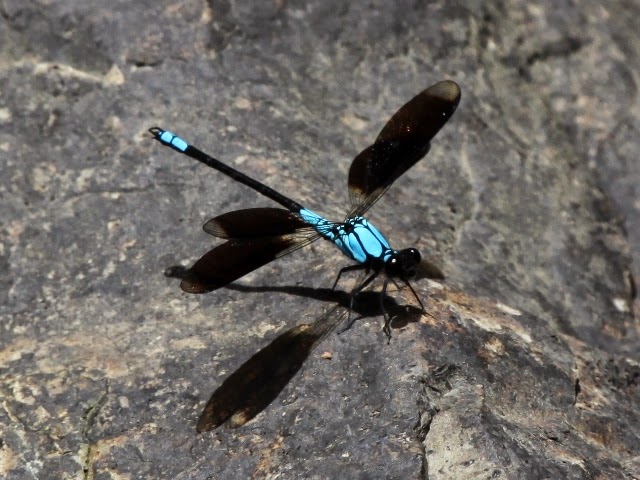.jpg) |
Tropical Rockmaster Diphlebia euphoeoides (Diphlebiidae),
Woogabba Creek, Bloomfield, 26 Nov 2011. |
.jpg) |
Tropical Rockmaster Diphlebia euphoeoides (Diphlebiidae),
Woogabba Creek, Bloomfield, 26 Nov 2011.
|
Telephlebiidae
This family
includes 39 species in eight endemic Australian genera (and as far as I’ve been
able to determine only occurs in Australia). It is essentially a family of
eastern Australia, though there is a single species in WA, and the adults are
generally known as the ‘southern darners’. Its status as a family, rather than
being treated as a subfamily of the Aeshnidae, is disputed by some. They are
large, slender dragonflies that are associated with running fresh water from
tropical rainforests to alpine environments, and even sand dunes.
The
Green-striped Darner Austroaeschna forcipata occurs in far north-east
Queensland, where it is largely restricted to rainforest streams. The one below
certainly fitted this criterion as it hung immobile in the dense shade of
rainforest plants adjacent to a tiny creek near our mountain accommodation in
the Daintree.
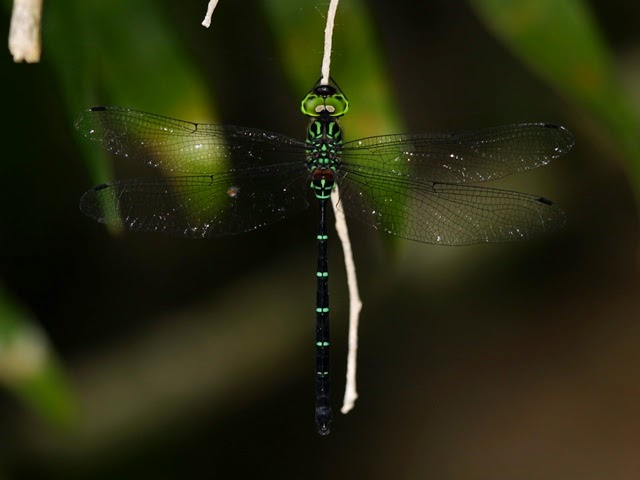.jpg) |
Green-striped Darner Austroaeschna forcipata (Telephlebiidae),
Daintree, 29 Nov 2011. |
Lindeniidae
This
family, the ‘tigers’ or 'wingtails' is recently split from Gomphidae, an action
which is far from universally accepted by taxonomists. They are
medium-sized to large black and yellow dragonflies, with clear wings, and the
eyes are distinctively widely separated, never meeting on top of the head. This
latter characteristic is more typical of damselflies. The family is represented
in Australia by just three species of Ictinogomphus, all endemic,
but the genus is represented by a further 13 species in Africa and Asia.
The
Australian Tiger Ictinogomphus australis inhabits both flowing and still
waters - rivers, riverine lagoons, lakes, and ponds - throughout eastern and
northern Australia. The one below was photographed at the Cattana Wetlands in northern Cairns.
The other two Australian species are more localised; one
to the northern tip of Cape York, the other to the Pilbara.
.jpg) |
Australian Tiger Ictinogomphus australis (Lindeniidae),
Cattana Wetlands, Cairns, 28 Nov 2011. |
Gomphidae
Commonly
referred to as ‘clubtail dragonflies’, or just ‘clubtails’, this is a large
family of about 90 genera and 900 odd species worldwide. They also have widely separated
eyes. Most species are associated with flowing streams or rivers. Seven genera, of which five appear to be endemic, account for the 36 species in Australia.
The Zebra
Vicetail Hemigomphus comitatus occurs along streams and rivers in far north-eastern Queensland. The ones I saw were on Woogabba Creek, in the rainforest to the east of Wujal Wujal and a little south of the Bloomfield River (the banner photo at the top of this post shows the habitat).
.jpg) |
Zebra Vicetail Hemigomphus comitatus (Gomphidae),
Woogabba Creek, Bloomfield, 26 Nov 2011. |
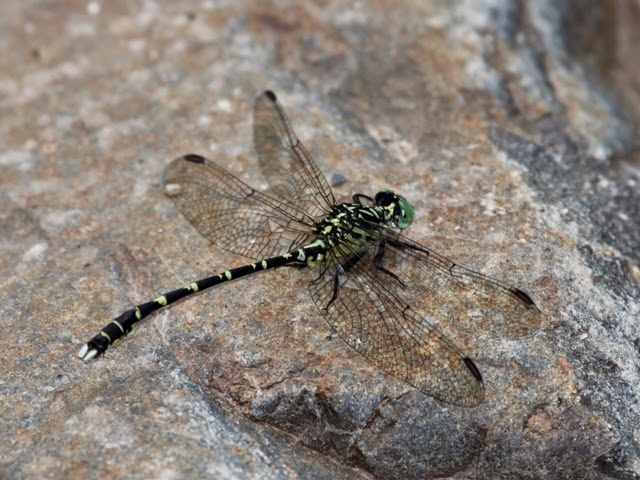.jpg) |
Zebra Vicetail Hemigomphus comitatus (Gomphidae),
Woogabba Creek, Bloomfield, 26 Nov 2011. |
The Rainforest
Vicetail Hemigomphus theischingeri also occurs only in far north-eastern Queensland, but unlike the Zebra Vicetail appears to be restricted to rainforest streams. I saw both the Zebra and the Rainforest together at Woogabba Creek.
.jpg) |
Rainforest Vicetail Hemigomphus theischingeri (Gomphidae),
Woogabba Creek, Bloomfield, 26 Nov 2011. |
Libellulidae
This is the
largest family of dragonflies, with well over a thousand species in about 140
genera worldwide. It includes the ‘skimmers’, the ‘perchers’, ‘gliders’, and
their allies, many of which are brightly coloured and obvious, and represent
the most commonly seen dragonflies. Despite their prevalence, they are
comparatively under-represented in Australia, which has a more Gondwanan bias
to its dragonfly fauna, but there are nevertheless around 50 species of
Libellulidae in Australia.
The Striped
Swampdragon Agrionoptera longitudinalis is associated with shady pools and tree holes, again from far north-eastern Queensland, but also extending into New Guinea. The one below was in the same Daintree rainforest garden as the Green-striped Darner above - it was a very profitable two-night stay for us (or at least for my dragonfly photo 'collection') and lived up to its name of Eden Escape.
.jpg) |
Striped Swampdragon Agrionoptera longitudinalis biserialis (Libellulidae),
Daintree, 29 Nov 2011. |
The Australasian Slimwing Lathrecista asiatica has a distribution stretching from India, through South-East Asia, to northern and north-eastern Australia; the Australian subspecies, festa, apparently being endemic. Based on the number of photos picked up by Google Images, this appears to be a fairly common species, and adults may be encountered far from water as well as near streams, rivers, lagoons and swamps. The ones I saw were in rainforest clearings at several places in Iron Range National Park (now called Kutini-Payamu NP). The females look quite different to the brighter red and green males.
.jpg) |
Australasian Slimwing Lathrecista asiatica festa (Libellulidae),
West Claudie River, Iron Range NP, 23 Nov 2011. |
.jpg) |
Australasian Slimwing Lathrecista asiatica festa (Libellulidae),
Scrubby Creek, Iron Range NP, 22 Nov 2011. |
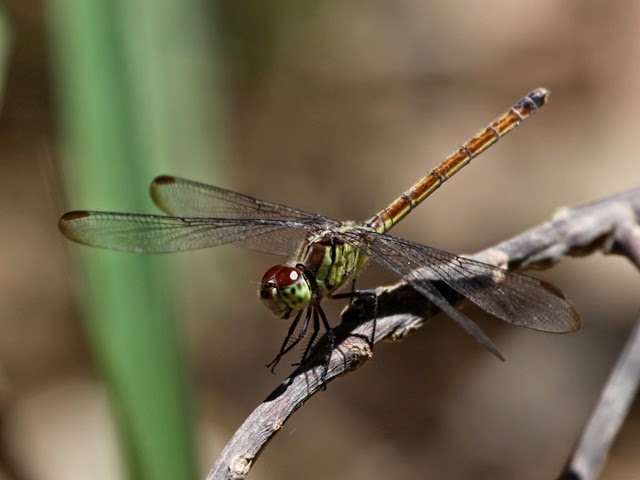.jpg) |
Australasian Slimwing Lathrecista asiatica festa, female, (Libellulidae),
Scrubby Creek, Iron Range NP, 22 Nov 2011. |
The Green Skimmer Orthetrum serapia is a species that prefers a variety of still or sluggish waters, and is distributed from the Philippines, through the south-west Pacific, and across far north-eastern and northern Australia. It is markedly different in appearance to several other species in the genus such as the common and widespread Blue Skimmer Orthetrum caledonicum, a chalky-blue dragonfly (at least the male is) that I seem to see pretty much wherever I go. The Green Skimmer I saw, very briefly, was at the Cattana Wetlands in northern Cairns, and the posture of this one, in the only photograph I managed to get, made it quite difficult for me to figure out what species it was.
.jpg) |
Green Skimmer Orthetrum serapia (Libellulidae),
Cattana Wetlands, Cairns, 28 Nov 2011. |
The Painted Grasshawk Neurothemis stigmatizans is another common dragonfly that I saw in lots of places around Iron Range NP, the Daintree region, and have also previously seen around Darwin and Litchfield National Park. They are very distinctive and immediately recognisable. They occur across the Top End and down the Queensland east coast (as well as to the north of Australia), breeding in a range of still waters, and are frequently seen congregating in clearings or grassy areas.
.jpg) |
Painted Grasshawk Neurothemis stigmatizans stigmatizans (Libellulidae),
West Claudie River, Iron Range NP, 23 Nov 2011. |
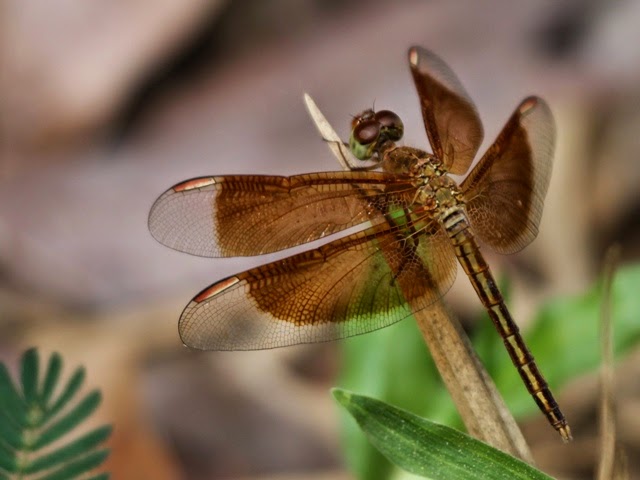.jpg) |
Painted Grasshawk Neurothemis stigmatizans stigmatizans (Libellulidae),
West Claudie River, Iron Range NP, 23 Nov 2011. |
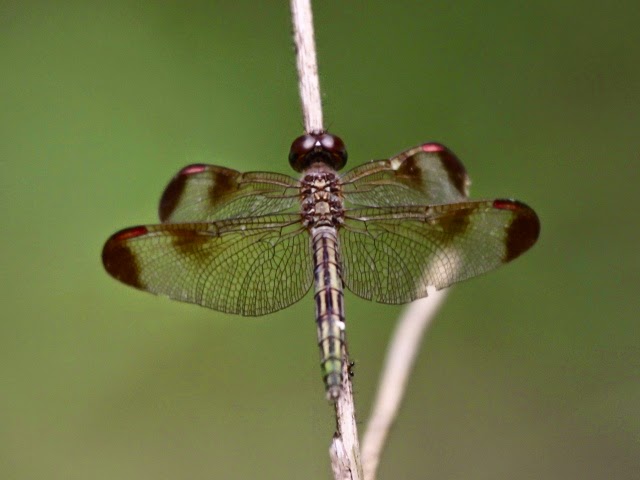.jpg) |
Painted Grasshawk Neurothemis stigmatizans stigmatizans, female, (Libellulidae),
Daintree, 29 Nov 2011. |
The Graphic Flutterer Rhyothemis graphiptera is also instantly recognisable and the ones I saw lived up to the name as they fluttered above and between the reeds at the edge of Lake Barrine in the Atherton Tablelands. They occur around riverine lagoons, lakes, ponds and swamps across much of Australia, and also in the Moluccas, New Guinea and New Caledonia.
.jpg) |
Graphic Flutterer Rhyothemis graphiptera (Libellulidae),
Lake Barrine, Atherton Tablelands, 2 Dec 2011. |
I first saw a Yellow-striped Flutterer, Rhyothemis phyllis, at the settling ponds of the Lockhart River sewage works (sewage works are always a great place for birds and dragonflies!) and was stunned. I hadn't seen a dragonfly anything like this before, but it was early days and I saw lots more of them in various places over the course of the trip. This species prefers a range of still waters, and apart from occurring across the Top End and eastern Queensland, is also found from Burma (Myanmar) to the western and southern Pacific.
.jpg) |
Yellow-striped Flutterer Rhyothemis phyllis (Libellulidae),
Cattana Wetlands, Cairns, 28 Nov 2011. |
.jpg) |
Yellow-striped Flutterer Rhyothemis phyllis (Libellulidae),
Lockhart River, 22 Nov 2011. |
And finally, the Common Glider Tramea loewii. This is a very common and widespread species in Australia and, unlike most of the species featured in this post, I'd seen it many times previously in all sorts of places. This one was at the Cattana Wetlands in Cairns. They utilise a wide range of still waters but I've also seen them far from water and they are clearly happy to fly large distances. They have a wide distribution stretching from the Cocos Islands, across Wallacea and New Guinea, to New Caledonia and the western Pacific
.jpg) |
Common Glider Tramea loewii (Libellulidae),
Cattana Wetlands, Cairns, 28 Nov 2011. |
My main reference for dragonflies is The Complete Field Guide to Dragonflies of Australia by Gunther Theischinger and John Hawking (CSIRO Publishing, 2006) - a really excellent guide and resource. They follow a tendency to 'split' families as taxonomic research advances, but as touched on above, the revisions are not necessarily accepted by all authorities (nothing new there!) For me, irrespective of any taxonomic or ecologico-political reasons, splitting at least gives a better 'feel' for the relatedness of the different species and groupings.
Below I've included a table that I compiled, mainly for my own benefit, that lists the odonate families that occur in Australia and indicates the number of genera and species in each (also just for Australia - and bearing in mind that such numbers are constantly in flux, due as much to differences in taxonomic opinion as to advances in research, and are, in the end, and to use an often-used expression of a friend of mine, just a human conceit!).
Another great resource is the Identification Guide to the Australian Odonata put out in 2009 by the NSW Department of Environment, Climate Change and Water (available as a pdf at http://www.environment.nsw.gov.au/resources/publications/09730AustOdonata.pdf ), and it's worth having a look at at Australian Damselfly and Dragonfly Photography at http://dl.id.au/g.php?c=3
Happy dragon-watching!
Traditional
|
Theischinger and Hawking 2006
|
Group Name (T&H 2006)
|
Genera
|
Species
|
Suborder Zygoptera
|
Suborder Zygoptera
|
Damselflies
|
37
|
113
|
Diphlebiidae
|
Diphlebiidae
|
Rockmasters
|
1
|
5
|
Chlorocyphidae
|
Chlorocyphidae
|
Jewels
|
1
|
1
|
Calopterygidae
|
Calopterygidae
|
Demoiselles
|
1
|
1
|
Hemiphlebiidae
|
Hemiphlebiidae
|
Greenlings
|
1
|
1
|
Synlestidae
|
Chorismagrionidae
|
Relicts
|
1
|
1
|
Synlestidae
|
Sylphs/Malachites
|
2
|
6
|
Lestidae
|
Lestidae
|
Spreadwings/Reedlings
|
3
|
14
|
Lestoideidae
|
Lestoideidae
|
Bluestreaks
|
1
|
4
|
Megapodagrionidae
|
Megapodagrionidae
|
Flatwings
|
5
|
22
|
Protoneuridae
|
Protoneuridae
|
Threadtails/Pinflies
|
1
|
12
|
Isostictidae
|
Isostictidae
|
Narrow-wings
|
7
|
15
|
Coenagrionidae
|
Coenagrionidae
|
Pond Damsels
|
13
|
31
|
Suborder Anisoptera
|
Suborder Epiproctophora, infraorder
Anisoptera
|
Dragonflies
proper
|
75
|
211
|
Petaluridae
|
Petaluridae
|
Petaltails
|
1
|
5
|
Austropetaliidae
|
Archipetaliidae
|
Tasmanian Redspots
|
1
|
1
|
Austropetaliidae
|
Mainland Redspots
|
1
|
2
|
Aeshnidae
|
Telephlebiidae
|
Southern Darners
|
8
|
35
|
Aeshnidae
|
Hawkers
|
7
|
13
|
Gomphidae
|
Lindeniidae
|
Tigers/Wingtails
|
1
|
3
|
Gomphidae
|
Clubtails
|
7
|
36
|
Synthemistidae
|
Synthemistidae
|
Tigertails/Southern Emeralds
|
8
|
26
|
Corduliidae
|
Gomphomacromiidae
|
Urflies
|
1
|
2
|
Pseudocorduliidae
|
Mistflies
|
1
|
2
|
Macromiidae
|
Cruisers
|
1
|
2
|
Austrocorduliidae
|
Southern Hawks
|
5
|
10
|
Cordulephyidae
|
Shutwings
|
1
|
4
|
Oxygastridae
|
Streamcruisers
|
1
|
1
|
Corduliidae
|
Emeralds
|
2
|
2
|
Hemicorduliidae
|
Modern Emeralds
|
2
|
11
|
Libellulidae
|
Urothemistidae
|
Baskers
|
3
|
4
|
Libellulidae
|
Skimmers/Perchers
|
24
|
52
|
.jpg)
.jpg)
.jpg)
.jpg)
.jpg)
.jpg)
.jpg)


.jpg)
.jpg)
.jpg)
.jpg)
.jpg)
.jpg)
.jpg)
.jpg)
.jpg)
.jpg)
.jpg)
.jpg)
.jpg)
.jpg)
.jpg)
.jpg)
.jpg)
.jpg)
.jpg)
.jpg)
.jpg)
.jpg)